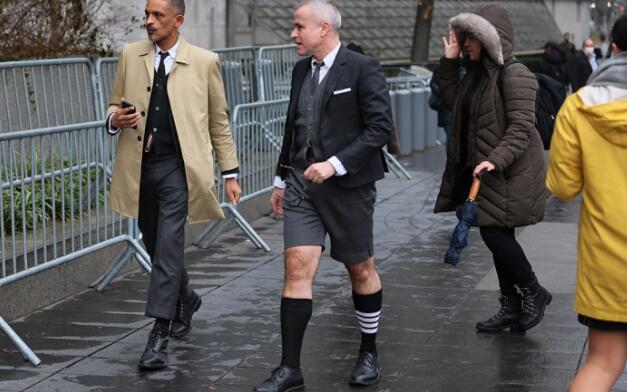7 Things to Know About the Adidas v. Thom Browne Stripes Trial
Adidas America Inc. started 2023 in court as the trial involving the brand’s 2021 trademark infringement complaint against Thom Browne Inc. kicked off Tuesday in Manhattan’s Southern District Court.
The trial in front of Judge Jed Rakoff began with attorneys on each side laying out their opening arguments to a jury, which will decide if the New York-based luxury designer infringed on Adidas’ trademark for its signature three parallel stripes pattern.
Here are seven things to know about the Adidas v. Thom Browne trial.
What Adidas is Claiming
Adidas first filed the lawsuit in June 2021, claiming Thom Browne’s four-stripe designs are “confusingly similar” to its three-stripe mark and violates the company’s trademark. According to a joint pre-trial consent order filed Dec. 27, Adidas alleges that Thom Browne’s use of certain parallel stripes on apparel and footwear infringes and dilutes its “three-stripe mark” and constitutes unfair competition. Specifically, Adidas alleges that Thom Browne’s “four-bar” and “grosgrain” designs (together Adidas refers to these as the “accused designs”) violate its trademark rights.
Adidas also claims that it first objected to Thom Browne’s use of three parallel stripes on its products in May 2007, and later objected to Thom Browne’s use of the grosgrain and four-bar designs in May 2018. Since then, the two parties have been engaged in “good faith” discussions to remedy the dispute, but were unable to find a resolution, according to the lawsuit.
At the trial, Adidas is expected to introduce examples of consumers reacting to images of the “accused products” online, including on social media, with references to Adidas. The company said these examples reflect actual association and, in some cases, actual confusion.
Adidas is also expected to introduce evidence of Thom Browne’s “bad faith” via the American fashion brand’s own documents and witnesses, which allegedly “make it clear” that the four-stripe design was adopted with full knowledge of Adidas’s three-stripe mark and multiple trademark registrations.
Thom Browne’s Defense
According to the same pre-trial document, Thom Browne will present evidence through fact and specialized witness testimony regarding the use of stripes, including three stripes and other numbers of stripes, generally throughout history and even today as a common design element. Thom Browne said it will also present testimony that the crowded field of use of stripes on clothing and footwear necessitates that consumers be more discerning when evaluating products bearing stripe marks — including Thom Browne’s products — and also narrows the scope of trademark rights that Adidas claims it owns.
What’s more, the fashion brand stated that the evidence of both parties will demonstrate that Thom Browne has always operated in the high-end luxury end of the market, while Adidas does not, and Thom Browne has sold clothing that Adidas labels as “activewear” for more than 15 years. “Thom Browne has never considered adidas a direct competitor,” the court document states. :To the contrary, even the more casual pieces across Thom Browne’s brand elicit a tailored, polished look and quality unlike traditional activewear—an elevated look and quality for which Thom Browne is recognized.”
What Thom Browne Needs to Prove to Win
In the pre-trial consent order, in order for Thom Browne to prevail at trial, the company must show that between spring 2010 (when it first offered one of the “accused products” for sale) and May 2012 (the relevant laches date, based on New York’s six-year statute of limitations), Adidas knew or should have known that it had a provable infringement claim against Thom Browne. The order also states that the fashion brand must also show that Adidas’s delay was unreasonable, and as a result of the sportswear company’s failure to object during that two-year window, Thom Browne suffered material economic or evidentiary prejudice.
What Adidas Needs to Win
In the same pre-trial document, Adidas must prove that it was unaware of any “accused products” during the two-year window and had previously settled its dispute with Thom Browne over a three-stripe design and trusted the fashion company to avoid further infringement. Adidas must also show that Thom Browne progressively encroached on its rights by “greatly expanding” the number and type of “accused products” sold in direct competition with Adidas, according to the court document.
Adidas Seeks Nearly $8 Million in Damages
Adidas is seeking damages in the amount of $867,225 — the amount that it said the company would have received in licensing fees and royalties from Thom Browne Inc., if the two had worked together — as well as the more than $7 million in profits it alleges the American fashion brand made selling apparel and footwear with similar stripes.
Both Parties Have Agreed Not to Discuss Kanye West and Balenciaga Controversies
In a seemingly odd twist, according to the pre-trial consent order, both Adidas and Thom Browne have agreed not to introduce evidence or discuss before the jury the recent controversies involving Adidas with both Kanye West and Balenciaga.
However, the document does state that both parties reserve the right to present evidence of these collaborations not related to the controversy. Adidas further reserves the right to present evidence in rebuttal if it believes it needs to explain the current status of either collaboration in response to evidence elicited by Thom Browne, the document added.
What Happens Next?
The trial is expected to last nine days before it is handed over to the jury for its decision. In the meantime, executives from Adidas and Mr. Thom Browne himself will take the stand to state their respective cases. Thom Browne CEO Rodrigo Bazan is slated to appear as well as former CEO Tom Becker.
